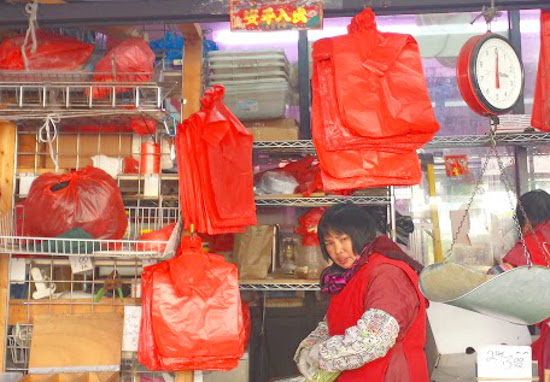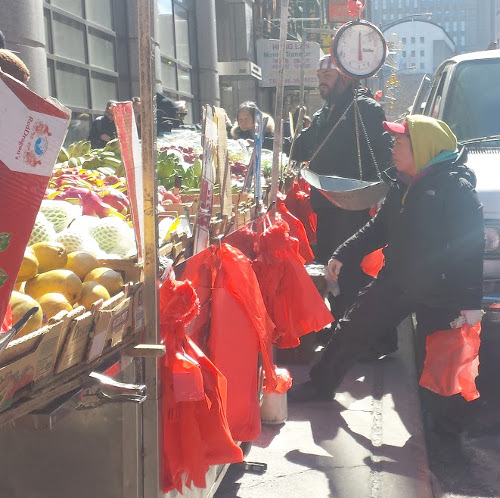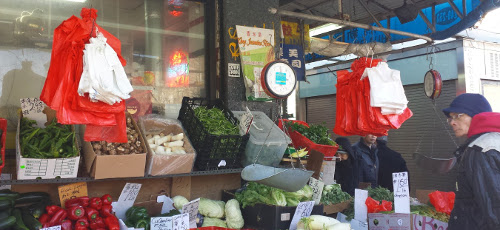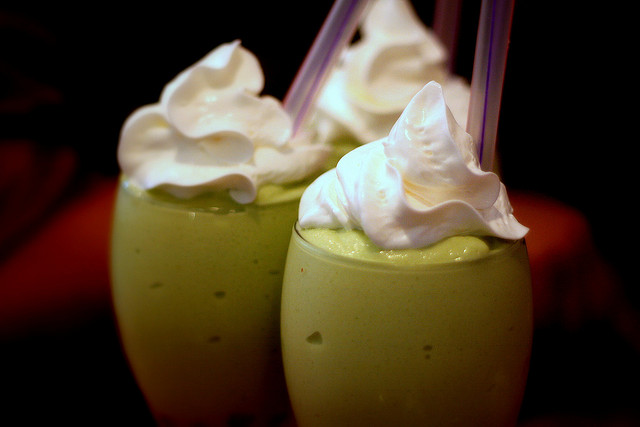Red is believed to be a lucky color and everyone wants to carry good luck with them. But that symbol of good fortune may soon carry something else: a 10-cent charge.

November 17, 2015
When I was young, my mother refused to pack my lunch or any of my school supplies in the seemingly thousands of red plastic bags that were stored in our kitchen cabinets. She had no trouble reusing them as our trash bags and even using them to carry her personal items in public but I was forbidden to use them.
Her reasoning? “Everyone will see that you are Chinese.”
As if my complexion, my see-yau (soy sauce) hair and eye color wouldn’t give me away. As though the bullies would make fun of the vine-ripe red tomato color of the bags I am carrying, and not the shape of my eyes or my small stature.
I try to point out the futility of my mother’s good intentions, but she dismisses me. For my mother, the red plastic bag was too much of a symbol of Chinatown.
“You are jook-sing, you are not from China. You were born here, you are American. Jook-sing do not carry Chinatown bags.”
Jook-sing is the Chinese word for first-generation, American-born Chinese.
“A coalition of city council members, …environmental advocates and others held a rally to press for the passage of a plastic-bag ban …(that) will require retail and grocery stores to charge 10 cents per single-use plastic or paper bag.”
At the time, I had just moved back home in southern Brooklyn after living with my grandparents for seven years in the Lower East Side where I went to P.S. 2 on the border of Chinatown. Whereas my primary school was attended by mostly Chinese-American students, my new junior high school was predominantly white. By that time, my family had lived in New York for a decade. According to my mother, making a smooth transition at my new school was the priority. Besides, there were plenty of other colored bags that I could reuse.
She does not offer me the same respite when we make our bi-weekly grocery shopping trips to Chinatown.
My mother did not make the same fuss either when I would occasionally help bag groceries at my father’s supermarket on Grand Street. That was my first “real job.” I had a good method going. I’d lick my thumb and index fingers and remove each individual bag with speed and efficiency. Heavier produce meant doubling the bags. But everything went into the bag — fruits, vegetables, whole fish and chicken, cooked roast meats.
Although my career path eventually led me astray from the ubiquitous plastic bags (but not before a promotion to cashier girl at my family’s supermarket), they are never far from my line of sight or my walking path. My knees have been gently grazed by the red plastic bag holding the Sing Tao Daily or World Journal on many a subway ride. I’ve also had the misfortune of having a whole durian slam into my thigh; its spokes poking through the red bags as I was trying to make my way through the crowd on Mulberry Street for great deals on fresh fruits.
The market price for oranges on Mulberry and Canal last week was five for $3. The market rate for the red ‘t-shirt’-style plastic bags that held my purchased mangoes is $10.50 for a 300-to-500-bag box, according to the sales department at Wing Sun Paper Supply Corporation in East Williamsburg. Wing Sun is one of the major wholesale suppliers of plastic bags to businesses and vendors in Chinatown.

But most street vendors get their plastic bags directly from delivery trucks carrying imported plastic bags in bulk, shipped to New York and New Jersey from China and Southeast Asia.
These trucks make the rounds each morning in Chinatown and the vendors can haggle with the truck drivers for a better price.
The trucks also carry white bags with smiley faces, or greetings such as “Thank You” or “Have A Nice Day” printed on them, but red is overwhelmingly the top choice in Chinatown.
“Red is a lucky color for the Chinese, everyone wants to carry good luck with them,” said the workers at the produce market at 249–253 Chrystie Street.
The fact that my family is obsessed with the color red is not lost on me. The red envelopes I received every New Year, birthday, and send-off before a big trip; the red qipaos that my aunts changed into for the tea ceremony on their wedding day – and in doing so, coincidentally, breaking a Western wedding tradition of not taking off one’s white wedding gown during the big day – are all reminders of the family’s reverence for the color red.
My aunts believed that good luck that wearing a red qipao on their wedding days would trump any Western superstition. It’s not surprising then, that we should want to add a prosperity element to even such a mundane event like grocery shopping.
By superstition standards, my family should be rolling in years of luck. There are currently, what seems like, thousands of red plastic bags that were stored in our kitchen cabinets.
That red plastic symbol of good luck, however, may soon carry something else: a 10-cent charge.

Earlier this year, on Earth Day, a coalition of city council members, community organizations, civic groups, environmental advocates and others held a rally to press for the passage of a plastic-bag ban, officially titled as Bill 209.
Bill 209 will require retail and grocery stores to charge 10 cents per single-use plastic or paper bag.
Council member Margaret Chin, who represents Lower Manhattan, which includes the Chinatown neighborhood, was one of those who sponsored the bill.
“In diverse communities all across the city, residents of all backgrounds say they’re ready to make the simple shift to reusable bags. Let’s take this historic step to reduce the waste stream in every New York City community by joining so many other cities in the worldwide effort to cut back on plastic bags,” Chin said at the rally.
According to Bill 209, “green markets” or street vendors will not be required to charge the 10-cent plastic bag fee. The fee will apply to single-use or reusable bags provided by covered stores to customers to carry out their purchased goods. Drug stores, pharmacies, stores, convenience food stores, and supermarkets are considered covered stores.
The proposed bag tax had come close to the 26-vote majority needed to pass in the council, but failed to win the support of Speaker Melissa Mark-Viverito or Mayor de Blasio.
There is, however, a renewed momentum to pass the bill under a compromise that would lower the proposed fee to 5 cents per bag.
“The plastic bags may look flimsy but they always seem to carry their weight from any of the Chinatowns to our final destination – home.”
If my family’s supermarket was still in business, I would’ve been, undoubtedly, tasked with making up signs in English to inform our customers of this new 10-or-5-cent bag fee.
Opponents of the bill have said a bag fee would hurt low-income families and senior citizens when they shop for groceries.
Undoubtedly, I would be roped into many debates and discussion on this chee seen (crazy in Cantonese) charge with customers if I was still working in my family’s supermarket. I personally think the ban would be conducive to reducing the amount of waste in the city. But of course I would never voice my liberal arts, collegiate opinion to the many aunties and uncles who would likely engage me in conversation about the ban and these silly lo-fan (Westerner) rules.
In China, one of the more popular shopping bag designs is a grosgrain bag, coincidentally, woven in the patriotic American colors of red, white, and blue. It is affectionately called the ‘Coming to America’ bag by my family and my Chinese-American friends. It was a popular travel bag of choice for many immigrant families. The woven fabric made it water-resistant and durable, ideal for holding together your family’s old life in China and transporting it on a 20-hour flight to a new life in America.
My mother still had her ‘Coming to America’ bag stashed in her bedroom closet. Disclaimer: We are also a family of hoarders.

The red plastic bags from Chinatown would never make it on a domestic flight, much less a transcontinental one. For the most part, the purpose of the bags is to withstand a 20-minute journey from Chinatown to Brooklyn. And to also bring home some good luck in the process is a happy coincidence.
I make this small journey almost every weekend with my Mom when we go on our grocery shopping trips to Sunset Park in Brooklyn or to Chinatown in Manhattan.
We would inevitably carry home, between the two of us, at least six-to-eight plastic bags filled with de-scaled fresh whole fish (with the shape of head and tail protruding along the sides of the bag), oranges (always a total of six or eight — again, for good luck), raw meats or roast meats, often times both, and whatever vegetables that were either the freshest-looking or were on sale.
The plastic bags may look flimsy but they always seem to carry their weight from any of the Chinatowns to our final destination – home.



